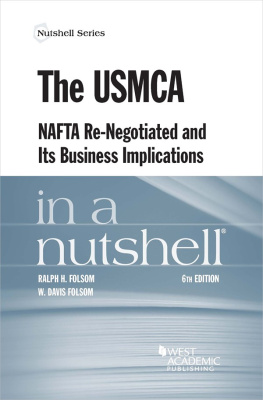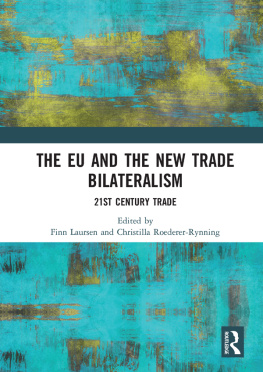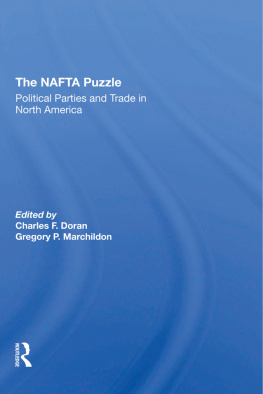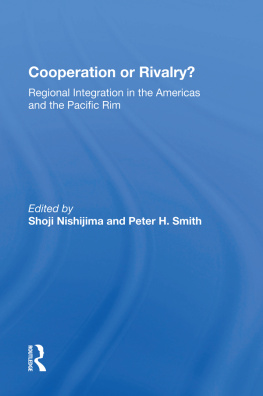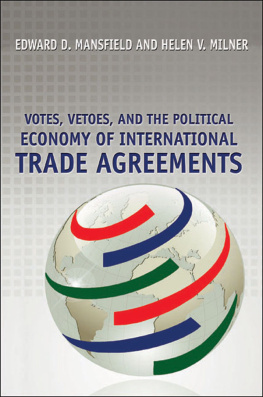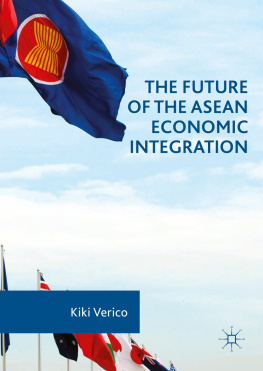
FREEING TRADE IN NORTH AMERICA
FREEING TRADE IN NORTH AMERICA
GREG ANDERSON
McGillQueens University Press
Montreal & Kingston Chicago
2020 Greg Anderson
Published in 2020 by McGill-Queens University Press
Published simultaneously outside North America by Agenda Publishing
ISBN 978-0-2280-0074-7 (cloth)
ISBN 978-0-2280-0075-4 (paper)
ISBN 978-0-2280-0076-1 (ePDF)
ISBN 978-0-2280-0077-8 (ePUB)
Legal deposit first quarter 2020
Bibliothque nationale du Qubec
We acknowledge the support of the Canada Council for the Arts.
Nous remercions le Conseil des arts du Canada de son soutien.
Library and Archives Canada Cataloguing in Publication
Title: Freeing trade in North America / Greg Anderson.
Names: Anderson, Greg, 1969 author.
Description: Includes bibliographical references and index.
Identifiers: Canadiana (print) 20190196181 | Canadiana (ebook) 20190196246 | ISBN 9780228000747 (cloth) | ISBN 9780228000754 (softcover) | ISBN 9780228000761 (ePDF) | ISBN 9780228000778 (ePUB)
Subjects: LCSH: North American Free Trade Agreement (1992 December 17) | LCSH: North AmericaEconomic integrationPolitical aspects. | LCSH: North AmericaForeign economic relations.
Classification: LCC HF1746.A53 2020 | DDC 382/.917dc23
Typeset by Newgen Publishing UK
Printed and bound in the UK by CPI Group (UK) Ltd, Croydon, CR0 4YY
CONTENTS
INTRODUCTION
Turtle Island
My exposure to the politics of international trade began in the mid-1980s, when Canadians were thrust into an existential debate among themselves over the future of their economic relationship with the United States. The catalyst was a proposed comprehensive free trade agreement between the two countries. Americans hardly batted an eyelash at the negotiations, but they transformed Canadas 1988 federal election campaign into a single-issue referendum on the future of the country. Just a few years later Americans and Mexicans confronted similar angst as all three North American states debated whether to support the North American Free Trade Agreement (NAFTA).
To students of North American integration, the bruising political debates that preceded the NAFTAs eventual implementation in 1994 can myopically appear to have been one of the most important events in the history of North America: time before NAFTA and then NAFTA. The NAFTA era was unquestionably a significant development in the political economy of postwar North America.
Yet it was hardly the first time anyone has thought about what North America is and what it ought to be.
When Christopher Columbus discovered the Americas in 1492, he quickly learned a lot of people had already discovered it. Indeed, by some estimates, there were as many as 100 million people spread throughout the Western Hemisphere at the time, many of them descendants of Asian migrants from a much earlier period (see C. Mann 2005; Jennings 1975).
The 1975 Pulitzer Prize for Poetry was awarded to University of CaliforniaDavis professor and poet Gary Snyder for his collection of poems entitled Turtle Island. It was a name given to what we now refer to as North America by aboriginal communities and derived from the creation myths common to many of them.
Snyder writes:
Turtle Island the old/new name for the continent, based on many creation myths of the people who have been living here for millennia, and reapplied by some of them to North America in recent years. Also, an idea found worldwide, of the earth, or cosmos even, sustained by a great turtle or serpent-of-eternity.
A name: that we may ourselves more accurately on this continent of watersheds and life-communities plant zones, physiographic provinces, culture areas; following natural boundaries. The U.S.A. and its states and counties are arbitrary and inaccurate impositions on what is really there.
The poems speak of place, and the energy-pathways that sustain life. Each living being is a swirl in the flow, a formal turbulence, a song. The land, the planet itself, is also a living being at another pace. Anglos, Black people, Chicanos, and others beached up on these shores all share such views at the deepest levels of their old cultural traditions African, Asian, or European. Hark again to those roots to see our ancient solidarity, and then to the work of being together on Turtle Island.
(Snyder 1974: introductory note)
In the aboriginal communitys vision of Turtle Island, we see a politically, economically and socially integrated land mass uninterrupted by the borders of the modern nation state, undivided by the exigencies of security, the politics of immigration or populist fear-mongering about what resides just beyond the border. Indeed, Turtle Island is a conception of North America that modern proponents of integration have pursued for decades, but has in recent years seemed more elusive than ever.
Whither North America?
The elusiveness of a modern, coherent unifying vision of North America stems, in part, from the way in which modern political borders have shaped (limited) our thinking about the continent. In some minds, there is no North America, nor should there be (see Corsi 2007). How can visionaries think of knitting together cultures shaped by three different European languages, distinct political cultures and unique experiences with colonialism and federalism? Turtle Island suggests such a vision is not without precedent. Yet modern North America is full of stark contrasts and divisions, many of which have become fodder for opponents of anything approaching Turtle Island.
Former New York Times correspondent Anthony DePalma recalls the experience of being reassigned to Toronto from Mexico City in 1996, two years after the NAFTA was implemented. During his time in Mexico there was no shortage of signals that DePalma was in a foreign country; language, culture and politics. Especially salient was the USMexican border, particularly near busy ports of entry that featured large fences, long lines, sceptical customs and immigration officials all standing in the way of easy entry and exit. Indeed, parts of the USMexican border are only slightly less militarized than the border separating North and South Korea; heavily armed patrols, surveillance aircraft, sniffer dogs and motion detectors are ubiquitous.
DePalmas arrival in Toronto was a different story. There were no sniffer dogs, no fences, no heavily armed staff; just a few questions from a customs inspector and a short wait while relatively friendly immigration authorities examined entry papers. Toronto felt so much like being in the United States that he subsequently forgot his passport as he checked in for a flight to New York; it was a pre-trip gaffe that resulted in several missed flights, but one he would never have made had he been making the same trip from Mexico City. DePalma had quickly assimilated into Canadian society because the differences between English Canadians and Americans are comparatively subtle. It was a point that was driven home even further several months later, when he and his family tried to arrange for their Mexico City housekeeper to join them in Canada. Unlike the experience of the DePalma family itself, the bureaucratic hurdles and restrictions placed upon their housekeeper were arduous. So much so, in fact, that their housekeeper stayed a mere six months, having felt alienated and unwelcome.
Next page





